March 22 show
Native plants and early Indiana botanical explorations
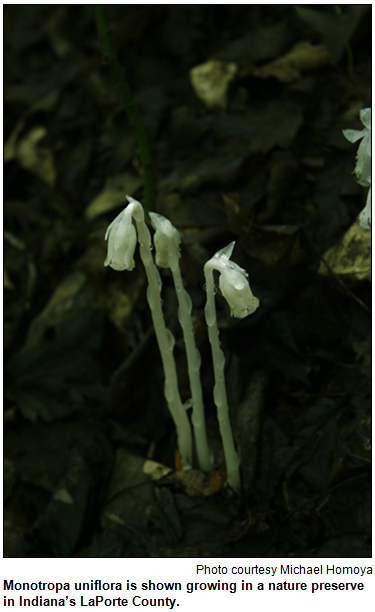 With, at long last, the arrival of spring - at least in terms of the calendar, if not the current weather - Hoosier History Live! will focus on our state's botanical heritage. And a special co-host will guide us during our look at native plants and early botanical explorations.
With, at long last, the arrival of spring - at least in terms of the calendar, if not the current weather - Hoosier History Live! will focus on our state's botanical heritage. And a special co-host will guide us during our look at native plants and early botanical explorations.
Did you know, for example, that 43 varieties of orchids are native to Indiana - more than in Hawaii?
Author and gardening expert Jo Ellen Meyers Sharp, who writes the popular "Hoosier Gardener" column for The Indianapolis Star, will join Nelson in studio for the show. Their guest will be a fellow author, botanist and plant ecologist Michael Homoya of the Indiana Department of Natural Resources. His books include Orchids of Indiana (Indiana University Press), which describes all 43 native Indiana orchids.
Jo Ellen, the co-author of The Indiana Gardener's Guide and the author of The Visitor's Guide to American Gardens (both published by Cool Springs Press), is the secretary of Garden Writers Association. She has been writing and speaking about natural gardening for more than 20 years.
So Jo Ellen and Michael will be ideal for this show, during which we will dig deep into botanical explorations across Indiana. The first known one occurred in 1795 by French explorer Andre Michaux. Some of Michaux's collections from the Indiana wilderness still exist in the national herbarium in Paris, according to Michael, who has personally seen them.
Our first state forester, Charlie Deam (1865-1953), grew up on a family farm in Wells County and went on to chronicle native plants across the state, including specific locations in counties and townships. 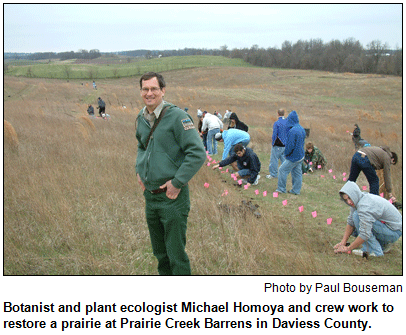 Known as the "father of Indiana botany," he collected more than 73,000 plant specimens from across Indiana, according to Michael Homoya. (His collection is now housed at the herbarium at Indiana University.)
Known as the "father of Indiana botany," he collected more than 73,000 plant specimens from across Indiana, according to Michael Homoya. (His collection is now housed at the herbarium at Indiana University.)
Some other insights about our state's natural history, courtesy of Jo Ellen and Michael:
- Short's Goldenrod(Solidago shortii) is one of the rarest plants in the world, only found in the wild in about two places in the country, including in Harrison County. The plant is now available in the garden trade as Solar Cascade, introduced by the Cincinnati Zoo and Botanical Garden. Short's Goldenrod is considered the most endangered plant in Indiana.
- Indiana ranks near the world's best for the show of forest spring wildflowers.
- The name of Thorntown in central Indiana comes from the Miami Indians, who referred to the area as "Thorn tree place."
-
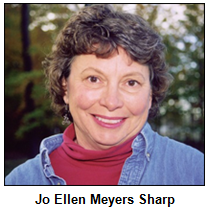 In 1915, a national contest was held to document the largest non-conifer tree in the country. A sycamore tree from Greene County was the winner; it was almost 14 feet in diameter.
In 1915, a national contest was held to document the largest non-conifer tree in the country. A sycamore tree from Greene County was the winner; it was almost 14 feet in diameter.
- Stella do Ora daylily was developed Walter Jablonski, a daylily hybridizer from Merrillville, and was introduced in 1975. It was the first re-blooming daylily.
In addition to his book about orchids, our guest Michael Homoya has been the author or co-author of other books about Indiana wildflowers. They include Wildflowers and Ferns of Indiana's Forests (IU Press).
And Jo Ellen, in addition to being an author and columnist, is a garden coach and landscape consultant. A frequent guest about gardening topics on TV and radio stations across Indiana, she is a member of Great Garden Speakers.
History Mystery
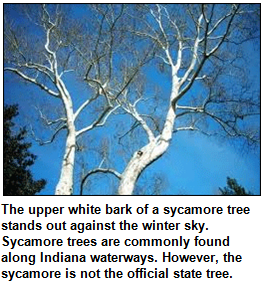 Question: What is the official state tree of Indiana?
Question: What is the official state tree of Indiana?
Sycamore trees shed their bark in winter, providing beautiful white branches to look at against the sky. However, the sycamore is not the state tree of Indiana.
The call-in number is (317) 788-3314. Please do not call into the show until you hear Nelson pose the question on the air, and please do not try to win the prize if you have won any other prize on WICR during the last two months.
The prize is a gift certificate to Howl at the Moon restaurant in downtown Indianapolis and two admission to the Benjamin Harrison Presidential Site, courtesy of Visit Indy.
Roadtrip: Circus Day at Indiana History Center
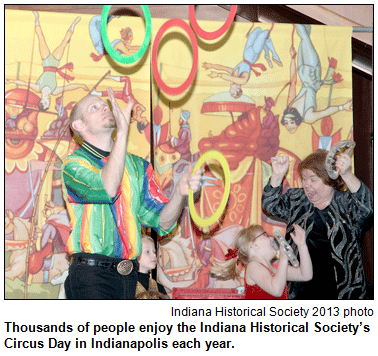 Guest Roadtripper Amy Lamb will suggest you run away to the Eugene and Marilyn Glick Indiana History Center at 450 W. Ohio Street in Indianapolis for the Indiana Historical Society's popular (and free) Circus Day celebration on Saturday, March 29, from 10 a.m. to 5 p.m.
Guest Roadtripper Amy Lamb will suggest you run away to the Eugene and Marilyn Glick Indiana History Center at 450 W. Ohio Street in Indianapolis for the Indiana Historical Society's popular (and free) Circus Day celebration on Saturday, March 29, from 10 a.m. to 5 p.m.
Many Hoosiers may not be aware that Indiana's connection to the circus industry dates back to the late 1800s. By the early 1900s, a number of the nation's premier shows set up winter quarters in Indiana. Today, Peru, Ind., is home to the world's largest amateur circus and the International Circus Hall of Fame.
The day will include performances from the Hampel Family Circus, the Amazing World of Animals, clowns, magicians and jugglers, as well as free admission to the Indiana Experience. Guests can purchase tickets to enjoy face painting, balloon sculptures, crafts and carnival games with prizes. For more information, visit www.indianahistory.org.
Your Hoosier History Live! team,
Nelson Price, host and creative director
Molly Head, producer, (317) 927-9101
Richard Sullivan, webmaster and tech director
Pam Fraizer, graphic designer
Garry Chilluffo, creative consultant
Joan Hostetler, Michele Goodrich, Jed Duvall, Dana Waddell, advisors
www.hoosierhistorylive.org






Please tell our sponsors that you appreciate their support: Indiana Authors Award | Indiana Historical Society | Indiana Landmarks | Lucas Oil | Story Inn | The Fountain Square Theatre Building

 Acknowledgments to Monomedia, Visit Indy, WICR-FM, Fraizer Designs, Heritage Photo & Research Services, Derrick Lowhorn and many other individuals and organizations. We are an independently produced program and are self-supporting through organizational sponsorships and individual contributions. We do not receive any government funding. Visit our website to learn how you can support us financially. Also, see our Twitter feed and our Facebook page for regular updates.
Acknowledgments to Monomedia, Visit Indy, WICR-FM, Fraizer Designs, Heritage Photo & Research Services, Derrick Lowhorn and many other individuals and organizations. We are an independently produced program and are self-supporting through organizational sponsorships and individual contributions. We do not receive any government funding. Visit our website to learn how you can support us financially. Also, see our Twitter feed and our Facebook page for regular updates.
6th-anniversary party
Party photos!
Over the next few newsletters, we will continue to share photos from our lovely and well-attended 6th-anniversary soiree. The Feb. 27 event at Indiana Landmarks was attended by about 200 history lovers, including dozens of guests on the Hoosier History Live program.
March 29 - encore show
Governors of Indiana
 "Historically, the office of governor in Indiana has been a weak institution compared to the strength of the state legislature and in contrast to the office of governor in some other states. Over time ... the office has been transformed into one with considerably more power."
"Historically, the office of governor in Indiana has been a weak institution compared to the strength of the state legislature and in contrast to the office of governor in some other states. Over time ... the office has been transformed into one with considerably more power."
So begins a book co-edited by two distinguished Hoosiers who are Nelson's studio guests for a show exploring the colorful array of Indiana's chief executives since statehood in 1816 - as well as various patterns among the political leaders who have held the top office.
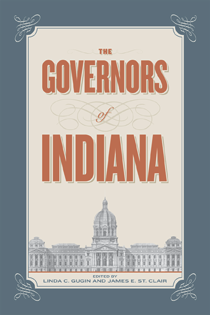 During this encore broadcast of one of the most popular shows in our Hoosier History Live! archives (its original air date was April 6, 2013), our guests are Linda Gugin, a professor emeritus of political science at Indiana University Southeast, and James E. St. Clair, a journalism professor at ISU. They co-edited The Governors of Indiana (Indiana Historical Society Press, 2006), an anthology to which dozens of writers contributed profiles of the Hoosier state’s leaders.
During this encore broadcast of one of the most popular shows in our Hoosier History Live! archives (its original air date was April 6, 2013), our guests are Linda Gugin, a professor emeritus of political science at Indiana University Southeast, and James E. St. Clair, a journalism professor at ISU. They co-edited The Governors of Indiana (Indiana Historical Society Press, 2006), an anthology to which dozens of writers contributed profiles of the Hoosier state’s leaders.
Our first governor, Jonathan Jennings, was a longtime foe of slavery who resigned in 1822 after being elected to Congress; he struggled with alcoholism in his later years. During our show, Nelson and his guests will explore how Jennings and other early Indiana governors - including William Hendricks of Madison (our third governor) and Paris Dunning of Bloomington (our ninth) - dealt with slavery-related issues.
In their book, Jim and Linda identify the two "most powerful governors" as Civil War-era leader Oliver Perry Morton, a Republican from Centerville, and Franklin native Paul V. McNutt, a Democrat who was the state's chief executive during the Great Depression. 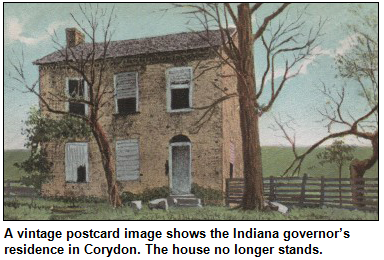 Morton had lost his first race for governor, in 1856, during a bitter election in which, according to our guests' book, Democrats resorted to "overt appeals to racism."
Morton had lost his first race for governor, in 1856, during a bitter election in which, according to our guests' book, Democrats resorted to "overt appeals to racism."
The election demonstrated "the polarized nature of the state at the time," with the Democratic candidate, New Albany lawyer and orator Ashbel Willard, prevailing in almost all of the southern counties and Morton in the north.
In 1860, Willard became the first of four Indiana governors to die in office. The most recent was Corydon newspaper publisher and state legislator Frank O'Bannon in 2003.
During the show, Nelson and his guests explore how various civil rights and social justice issues have been handled by governors. A former first lady, Zerelda Wallace, became a leading suffragist during the 1870s and '80s, lobbying the legislature for women's rights. She was the second wife of David Wallace, who had served as governor in the 1830s. Fun fact: His son from his first marriage is Lew Wallace, who went on to write the international bestseller Ben-Hur.
© 2014 Hoosier History Live! All rights reserved.